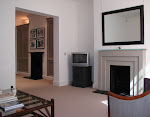As new interior design trends emerge our level of confidence wains and, periodically, we tend to follow new, strict, unwritten rules. As we absorb and come to better understand new influences, we appear to gain the necessary confidence to break some of those rules. Over the last few years British interior design has become familiar with oriental influences, retro design, simplified structural detailing, subtler use of colour and overall cleaner lines. This new "language" of design has now become so familiar that many designers are attempting slightly richer combinations.
While leafing through an old copy of Architectural Digest (Italy, Jan 2008) I came across a photograph which illustrates this approach. Interestingly however, the project belongs to a design firm based in Brescia (Angelo Brignolli and Antonio Feraboli of Studio Linea) whose background, judging by their online portfolio, is very different to that of their UK counterparts. Most of their projects appear routed in the history of Italian architecture and furniture design and executed in conpemporary style. In the bedroom shown above the predominance of clean lines and good proportions allow the designers to play with colour and softened shapes. Ethnic influences are interpreted, not slavishly obeyed. The resulting elegance in no way forfeits comfort or warmth: an interesting example of contemporary UK design from Italian designers! There are obviously many routes one can follow to competent design...








